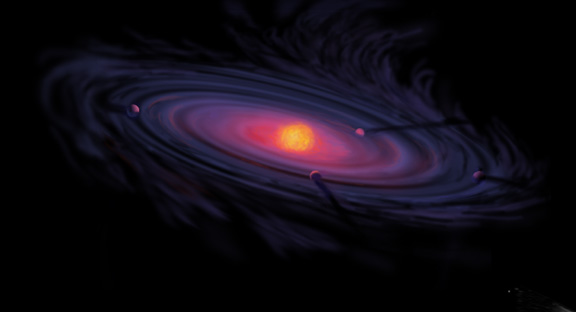
[Image of Protoplanetary disk, by NASA from WikiMedia]



Aaron Sloman
University of Birmingham, UK
PDF Slides updated after the talk:
http://tinyurl.com/CogTalks/#m-m
Also on Slideshare.net in flash format.
Video recordings at the conference:
OVERVIEW
This highly interactive tutorial will introduce what seems to be a partly new way of
thinking about biological evolution, that I suspect Turing might have developed had he
lived longer, and which seems to be capable of contributing both to the aims of AGI
researchers and to AI (as construed by McCarthy and others at its birth), to Cognitive
Science, to evolutionary Biology, and to several old branches of philosophy that are ripe
for a new injection of vigour.
The history of our planet demonstrates the following:
[Image of Protoplanetary disk, by NASA from WikiMedia]
Starting merely with a rich enough physical/chemical machine, even a cloud of dust,
without any external input apart from solar energy, other stellar radiation (especially
light), and occasional disruptive physical perturbations (e.g. asteroid impacts), it is
possible for every feature of both natural and artificial intelligence that has ever been
manifested on earth to be produced -- and presumably many more, since the processes
are continuing; and there are many branches that could have been taken but were not
taken, e.g. what might have happened if there had not been highly disruptive asteroid
impacts, or if there had been different impacts at different times?So, a sufficiently large and complex, multi-component, knowledge-free
physico-chemical machine is capable of producing every sort of intelligence, and
every sort of product of intelligence, that has so far turned up on earth, without
needing an external teacher or programmer, though it may take a very long time and
require a huge amount of parallelism to allow effects of competition and cooperation
to play a major role, and also to allow high level requirements to feed back into
very low-level designs (e.g. adding neural computation to chemical computation, and
also extending chemical computation by selecting more complex forms that serve higher
level needs).The results include Euclid's elements, the idea of a Universal Turing Machine, proofs
of incomputability and undecidability, sonnets, plays, paintings, symphonies,
skyscrapers, airliners, bombs, democracies, dictatorships, wars, murders, acts of
kindness, pandemics, elephants, ants, and this tutorial proposal.
DRAFT Overview
The tutorial will introduce and give illustrative examples of the Meta-MorphogenesisTO BE REVISED AND EXTENDED
project: a multi-disciplinary long term project aimed at understanding how changes in
biological information-processing make it possible for evolution to have such
products -- partly inspired by Alan Turing's 1952 paper
"The Chemical Basis Of Morphogenesis," Phil. Trans. R. Soc. London B 237, pp. 37--72,A major feature of the project is an attempt to complement existing evolutionary
studies of (a) physical forms, (b) physical behaviours, and (c) genetic specifications
of organisms produced by biological evolution, by attempting a survey of:
(d) the major transitions in information-processing in biological evolution and its products:
a particularly difficult task because information processing is mostly invisible, and
leaves no fossils.I shall try to explain how we can make progress, as illustrated by the many
transitions in information-processing (over 70 types and still growing) described in
this draft, incomplete survey:
http://www.cs.bham.ac.uk/research/projects/cogaff/misc/evolution-info-transitions.htmlOne of the key hypotheses is that the mechanisms that enable biological evolution and
its products (such as development, learning, social evolution) produce new mechanisms
that change the processes of evolution, development, learning and social evolution:
which is why 'Meta-' is required in the label.Another hypothesis is that it is scientifically counter-productive for the research community
to aim for one design (or schematic design) for an intelligent system.That can be compared with a research community trying to do chemistry by studying
one very complex molecule, e.g. haemoglobin,Another hypothesis is that the evolution of forms of life and intelligence found on
earth would be impossible but for features of the underlying medium supporting chemical
information processing, namely the ability of structures that can change continuously,
and also "snap" into (and out of) discrete stable states resistant to thermal buffering
and other potential disruptions.As a research community, we'll acquire a much deeper understanding of complex products
of biological evolution, or human engineering, if we understand how they relate to
alternative designs, including many kinds of much simpler designs that provide important
building blocks or stepping stones. This does not rule out individual researchers
focusing on special cases, as long as they understand that they are special cases of
something more general.Another hypothesis is that the environmental challenges and opportunities that drive
biological evolution continually change, so that the requirements to be met by
successful designs continually change, sometimes slowly and sometimes quickly (e.g.
after major disasters). In particular, the presence of new sorts of intelligent agents
in the environment, including both conspecifics and others (prey, predators, competitors
for resources, symbiants) can feed new kinds of complexity back into the requirements to
be met by later designs (whether produced by evolution or learning and development). So
the study of intelligence is the study of something that continually changes in a manner
that is not merely homogeneous accumulation. (That is also illustrated by the
development of science and the development of mathematics.)
(This generalises some old ideas about co-evolution involving "arms races", by John
Maynard-Smith and others.)Background documents:
- http://www.cs.bham.ac.uk/research/projects/cogaff/misc/triangle-theorem.html
- http://www.cs.bham.ac.uk/research/projects/cogaff/misc/evolution-info-transitions.html
- http://www.cs.bham.ac.uk/research/projects/cogaff/misc/meta-morphogenesis.html
- http://www.cs.bham.ac.uk/research/projects/cogaff/misc/toddler-theorems.html
- http://www.cs.bham.ac.uk/research/projects/cogaff/misc/beyond-modularity.html
- http://www.cs.bham.ac.uk/research/projects/cogaff/#overview
[To be extended.]
Installed: 8 Nov 2012
Updated: 9 Nov 2012; 14 Nov 2012; 24 Nov 2012; 20 May 2013; 15 Jan 2014
Maintained by
Aaron Sloman
School of Computer Science
The University of Birmingham